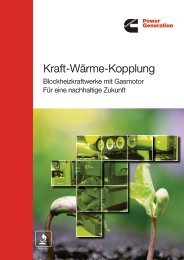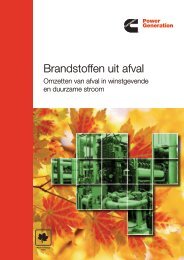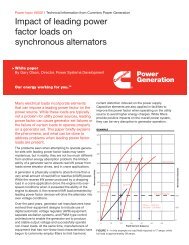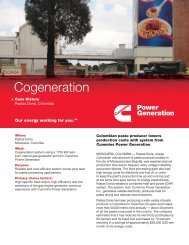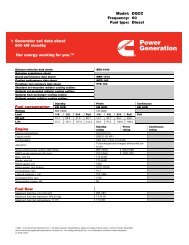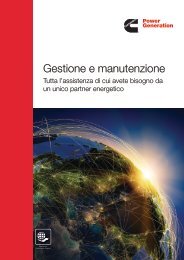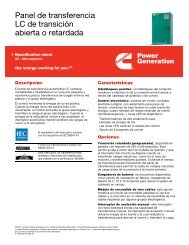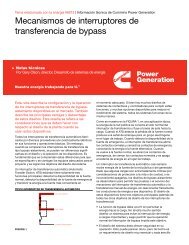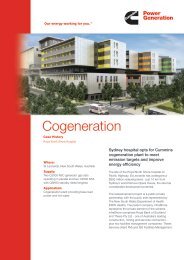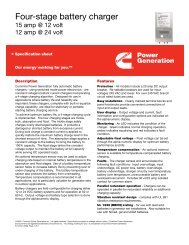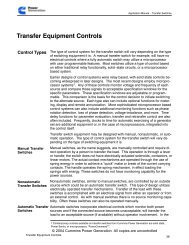appendix
appendix
appendix
Create successful ePaper yourself
Turn your PDF publications into a flip-book with our unique Google optimized e-Paper software.
Application Manual – Liquid Cooled Generator Sets<br />
Altitude and Ambient Temperature<br />
Based on geographic location, the size of the generator set the software recommends<br />
may be increased for a given level of performance as altitude and/or ambient<br />
temperature increase. The default values are an altitude of 500 feet (152 meters) and an<br />
ambient temperature of 77° F (25° C).<br />
Sound Attenuation<br />
The default setting is None. However, a Quiet Site generator set may be selected. Quiet<br />
Site units include special exhaust silencers, a sheet metal housing with sound attenuating<br />
insulation, and/or intake and discharge dampers. Not all models are available in a Quiet<br />
Site configuration. When selecting Sound Attenuation, GenSize generator set<br />
recommendations will be limited to standard optional packages available from the factory.<br />
Your local distributor, however, should be consulted for any other sound attenuation<br />
needs.<br />
Maximum Alternator Temperature Rise<br />
A maximum allowable temperature rise over an ambient of 40° C (104° F) can be<br />
specified for the alternator windings. GenSize will recommend engine–alternator<br />
combinations that limit the alternator temperature rise to the specified temperature when<br />
powering the specified connected loads. It may be desirable to use lower temperature<br />
rise alternators in applications that contain significant non–linear loads, where better<br />
motor starting is required, or in prime duty applications. The default setting is 125° C.<br />
Note that, when you select a lower temperature rise alternator, you may increase the size<br />
of the recommended generator set to accommodate a larger alternator.<br />
Fuel<br />
The default fuel is Diesel. Other choices of available fuels are Natural gas and Liquid<br />
Propane Gas. An “Any Fuel” choice is available which allows GenSize to compare the<br />
performance of all available fuel choices.<br />
Note: For gaseous fuels requirements above approximately 150/140 kW, consult the distributor.<br />
Frequency<br />
Specify the required operating frequency. Generator sets are configured for either 50 Hz<br />
or 60 Hz. The default value is 60 Hz.<br />
Phase<br />
Select either a single– or three–phase generator set. The default setting is three–phase.<br />
If selecting single–phase, only single–phase loads are allowed. Selecting single–phase<br />
will also limit the number of available models since larger generator sets are not available<br />
with single–phase generators. The default three–phase selection permits single–phase<br />
loads but GenSize assumes that the single–phase loads will be balanced across the<br />
three phases.<br />
Duty<br />
GenSize makes a recommendation based on the standby or prime power rating of the<br />
generator set, derating appropriately for site conditions. The default setting is Standby.<br />
For further discussion and illustration of system and generator set ratings see Preliminary<br />
Design section.<br />
A standby power system is an independent power system that supplies a facility in the<br />
event of a failure of the normal power source. (It is assumed that the generator set is<br />
isolated from the utility service.) The standby power rating is applicable for emergency<br />
power duty for the duration of a typical power interruption. No overload capability is<br />
available for this rating.<br />
A prime power system is an independent power system for supplying electric power in<br />
lieu of purchasing power from a commercial utility. (It is assumed that the generator set<br />
is isolated from the utility service, or that utility service is unavailable.) The prime power<br />
rating is the maximum power available at variable load for an unlimited number of hours.<br />
A–6 APPENDIX A<br />
Rev. Jan 2011



